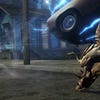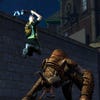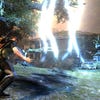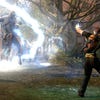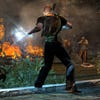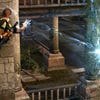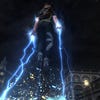inFamous 2
Karmageddon.
Alongside an improved range of environments, New Marais also has many more moving parts than Empire City: balconies that collapse under sustained attack, cars that you can turn into electrical trampolines, and weird power strips than boost you smartly up the side of a building. It's the perfect fit for a game that has so much of Sly Cooper's chimney-hopping DNA flowing through it.
While this New Orleans pastiche may not quite have the individual identity of other open-world cities, it's been built for traversal rather than tourism - and traversal, with its magnetic drainpipes and endless grindwire trails, remains the series' trump card. A touch more involved than Assassin's Creed and a lot less fiddly than Mirror's Edge, inFamous 2 is video games' true master of parkour, and your agility is enhanced by tech that has improved considerably since the first game. Forget the fact that the draw distance still isn't perfect: Cole MacGrath finally has a frame rate that can keep up with his headlong pelt.
At times, in fact, traversal almost overwhelms the rest of the adventure. Despite all those new powers you can mess about with, combat still struggles to match the thrills offered by simply getting around. Even here, though, there have been improvements.
They're particularly obvious in terms of melee, where Cole's close-up attacks have been channelled into the Amp, an electrical club built from motorbike parts that provides fights with some endearingly brutal moments. The bestiary you'll be Amping is bigger and a lot more inventive, too. Expect a handful of different foot soldiers and some pleasingly disturbing monsters to kick off against, while, alongside best friend Zeke, Cole's joined on his side of the struggle by two fellow Conduit superheroes. They behave, for the most part, like different aspects of his conscience, and that's about all that can be said of them without dipping into spoilers.
The final piece of the puzzle is user-generated content, which, in the weeks ahead, should see New Marais steadily filling up with the green waypoint icons that indicate the starting areas for home-made side quests.
Playing through the game in pre-release, most of these are currently built by the team at Sucker Punch. As offerings go, if you put aside the lack of voice tracks and bespoke sound effects, they're up there with the campaign missions in terms of complexity and storytelling. Whether you're living out one of Zeke's tall tales or visiting a deadly outdoor disco, the creator tools are clearly capable of providing multi-part set-pieces with plot twists and bosses, as well as the expected range of ring-races and simple brawls.
This level of control doesn't come without a price, of course, and actually building UGC is something that, as a creator, you're going to have to put aside some time to get used to. It's more LittleBigPlanet than ModNation Racers, in other words, and there's a serious learning curve as you get to grips with placing NPCs, modifying their states, and laying down game logic. (Every design element, from event triggers to dialogue boxes, appears in creation mode as a physical object, incidentally, and to make things work, you literally wire the parts of your mission together.)
There are templates to learn from, but I actually found it less daunting to build things from scratch and then slowly incorporate new elements after I'd messed around with them enough to get a vague understanding of what they do. Within 20 minutes, I went from utter confusion to having constructed a very basic seek-and-destroy mission, and within a half-hour, I was adding a second wave of monsters to my original design. It's not for the faint-hearted (the content creator that is, not my level, which was reassuringly feeble) but it's a brilliant set of tools, and the important stuff for most of us, like uploading, rating and recommending content, is kept straightforward throughout.
UGC aside, inFamous 2 is a great example of the iterative approach to sequels: it's driven by tweaks, fixes, and subtle refinements, and there's a sense throughout that the series is starting to come into focus. During its best moments, it feels like something we might have been given by the Assassin's Creed team if they'd grown up immersed in the works of Steve Ditko rather than Umberto Eco: a hard-edged pulp adventure where your tools are perfectly matched to your missions. If the original game gave Cole a purpose, this one provides a little personality to go with it.
In other words: onwards and upwards.

